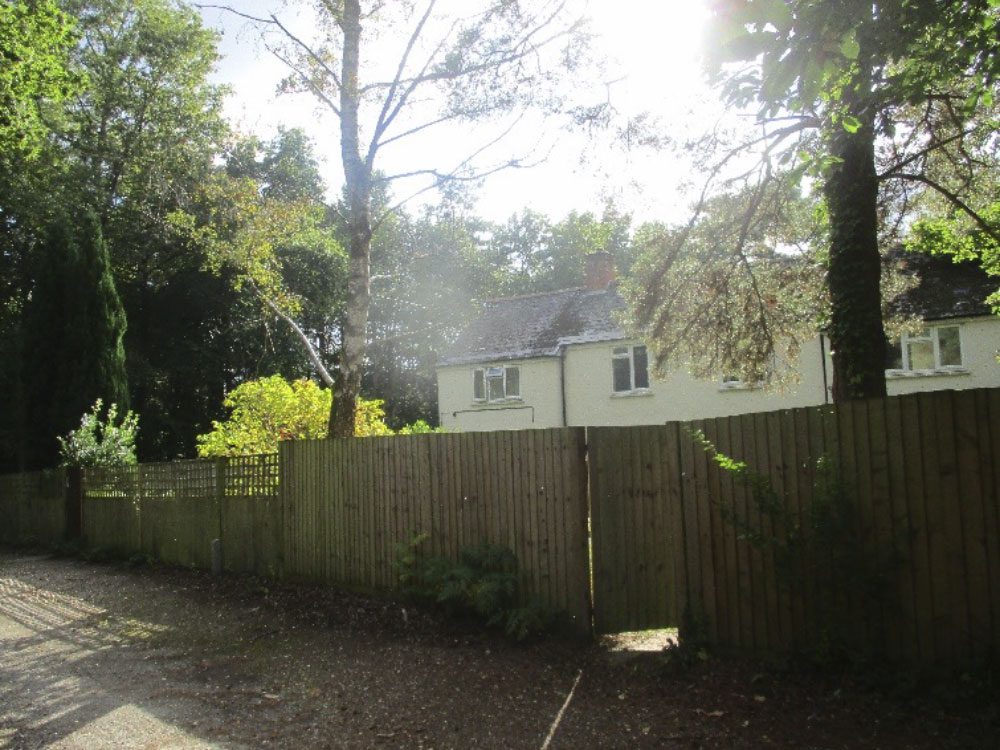Berkshire, Crowthorne RG45 7PU
CONTRACT COMPLETION DATE 9th May 2022
Wellington College, founded in 1859, is set in the heart of Berkshire, amongst 400 acres of leafy woodland and picturesque grounds.
The College secured planning permission and listed building consent to demolish existing buildings and structures at Woodland Quad and replace with a new Boarding House and Day House which were to be sensitively integrated into the woodland setting.
Google Earth image – Demolition and enabling works package area demarcated in a red pathway outline.

Proposed visual of student accommodation within woodland context.


Woodland Quad comprised primarily of the following buildings and structures:
1. Non-listed two semi-detached armoury cottages

2. Listed Old Laundry House disused from around the 1960’s

3. Above ground oil storage tanks

4. Staff residential dwellings

5. Historic reservoir which had been infilled and developed with temporary classrooms by mid-2010.

6. Associated borehole and underground chambers

7. Outbuildings used to store furniture and equipment.


Dorton Demolition & Excavation Limited (Dde) were awarded the demolition and enabling works contract through competitive tendering.
Brief summary of the demolition and enabling works package:
1. Dde completed a photographic schedule of conditions of existing neighbouring properties and roads.
2. Approximately 50 trees were marked up to be felled on the Arboricultural Tree Retention & Removal Plan. Dde undertook the felling works as soon as possession of the site was given, due to the imminent start of the bird nesting season in February. Mature trees were approximately 18m tall across the site. Some trees were soft felled under ecological watching brief due to their bat roost potential. Tree stumps and roots in the footprint of the proposed new development were grubbed up and disposed from site.


3. Immediately on taking possession of the site, Dde also carried out ecological preventative works to the existing buildings. This was to temporarily cover up openings in the buildings due to disrepair – doors, windows, roofs and fascias – to deter birds from nesting inside. The preventative works were carried out following a survey by the ecologist of internal spaces.


4. Disconnection and capping of services primarily electricity, gas, and underground drainage systems. These had been modified over the years by numerous different contractors. Data from an underground utility survey was marked on site and trial pits excavated to trace live service routes and capture obsolete services and obstructions.




5. To negate disturbance to school traffic, permission was obtained to use a tertiary route around the college leading to the golf course. A temporary access route was formed for a small section through the woodland onto the site. Specialised heavy duty Groundguard ground protection mats were laid on imported free draining angular gravel material on a geotextile membrane.


6. Dde were responsible for the design, supply and erection of temporary free standing timber hoarding, installed using above-ground support and ballast, to site boundaries away from the woodland.


7. Tree protection fencing was erected as woodland boundaries in accordance with the Arboricultural Tree Protection Plan.




8. Dde removed all licensed and non-licenced asbestos contaminated materials positively identified.
9. All buildings and structures within the demolition site boundary were fully soft stripped and then demolished to existing ground levels.
10. Roof coverings, fascias, soffits, hanging tiles were removed by hand under the supervision of an ecologist.


11. Ground bearing floor slabs and foundations were broken out down to 2.00m below existing surrounding ground levels. The soil beneath the Old Laundry and above ground oil tanks was sampled and tested to confirm that it had not been adversely impacted by any leaks or spills.
12. A large reservoir was broken out and the hardcore arisings removed from site. The inert historic fill hardcore material was re-used to backfill the excavation in properly compacted layers.




13. An associated large underground chamber was stripped of pipework, water pumped out, borehole sealed and capped, chamber walls removed to 2.00m below existing surrounding ground levels, and the resulting pit backfilled with site won recycled crushed hardcore material in properly compacted layers.




14. Waste demolition arisings were systematically and progressively removed from site. Bricks were cleaned and palleted.




15. A large spoil heap was removed from site and the material transported to form boundary bunds to a new workshop area in the college grounds. A soil investigation report recorded hazardous made ground to one trial pit with elevated concentrations of PAHs and locally TPHs and Lead. Further trial pits were commissioned and the hazardous ground removed from site to a licensed landfill site.






16. The entire demolition site area was graded on completion to follow existing contours of the immediate surrounding land. Borders were left smooth and flowing where possible with falls for adequate drainage. Imported and site won crushed hardcore arisings were used in backfilling voids and excavations as necessary.






17. Dde took all necessary precautions to prevent nuisance from excessive noise, exhaust fumes, dust, unsightly rubbish, and other causes so that functions and events planned within the school, continued to operate uninterrupted throughout the duration of the project.
All demolition arising materials were segregated for recycling or disposal. Asbestos contaminated materials were taken to a licenced tipping facility. Surplus aggregate arisings were taken to a local recycling yard and processed for reuse within the construction industry. Bricks, roof tiles and timber floor boards were salvaged and taken to our large reclamation yard in Burgess Hill, West Sussex.
A meeting point was arranged for delivery lorries which were then escorted to site. A banksman directed all traffic movement outside the site boundaries. Access to internal college road and footpath network was maintained throughout the demolition period. Parking of site vehicles was confined within the dedicated site compound. Wheel washing and road sweeping was managed on a daily basis. A water dampening system provided regular dampening down for dust control.
Demolition was completed on time and within budget. There were no accidents or reportable incidents on site. Regular communication with the college and neighbouring residents and prompt response actions resulted in excellent feedback.